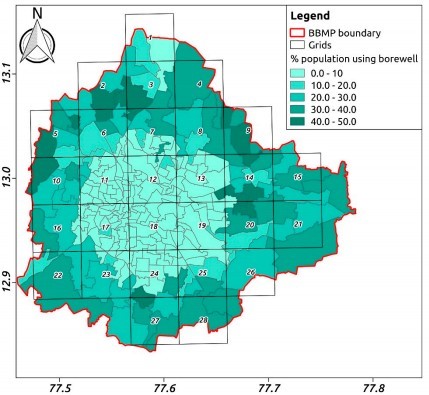In the glory of the green blanket that enveloped 69 percent of its land, Bangalore in the late 1900s was branded as the “The Garden City” of India. It was home to 2000+ varieties of trees and small gardens that adorned its magnificent biodiversity. The green suit of armour being liable for Bangalore’s cool and pleasant climate. The wave of urbanisation led the path from being the city of gardens to “The Silicon Valley” of India. The inverse relation between economic growth and environmental survival is hysterical. The evident rises in temperature over the years justify the crucial demise of forestry to a mere 2 percent and one third the area of lakes. The depletion of these natural resources in Bangalore from its yesteryears is below. The picture is a satellite captured multi-resolution image data, estimating the fragmented biodiversity spread in urban areas.

Between the years 1981 to 2004, Bangalore was awarded the title of the fastest-growing city in India. The population too doubled, rising from 3 million to almost 6.1 million. These rising numbers fast-paced the slow metamorphosis into a disruptively transient evolution. It also brought along the virus of limitless traffic. This virus led to a solution by the Karnataka Road Development Corporation Limited to axe more than 8,500 trees in Bangalore.

Another concern due to significantly losing control over the population is Carbon emissions. Studies showed that to control carbon dioxide emission, every person requires eight trees. Whereas, according to the research held by IISC in 2014, there was one tree for every seven people. This number has been severely depleting over the years. Combined with the increasing population, it is becoming an alarming threat.
Where deforestation of the city of gardens is a concern, the scarcity in groundwater levels provokes the attention of instantaneous stimulus. Groundwater is the imperial and decentralised source of drinking water to the masses. It provides for nearly 85% of rural domestic and 50% of urban water needs. With the ever-growing population, the Bengaluru Water Supply and Sewerage Board (BWSSB) has not been able to keep up with the rising demand. The CGWB suggests that due to the deficits, the extraction is more than the recharge that means that groundwater sources are depleting with the increasing population.

There is an unnerving and unending cycle starting from deforestation leading to global climatic change. Which in return affects rainfall patterns, ultimately arriving at the sustainability of groundwater levels. Deforestation and a decrease in groundwater levels establish the relation between the condescending behaviour of urbanisation on the ecosystem.
These twins of ecological downfall have not only tampered with Bangalore’s climate but also hampered its socio-economic development in the following ways:
- In the earlier days, the highest temperature recorded in Bangalore was 21 degrees celsius. The highest has now risen to 41 degrees celsius, deluding the pleasant climate.
- Loss of vegetation and water bodies has impacted the serendipity and virtue of the surroundings.
- Frequent droughts and changes in rainfall patterns
- Fall in the water table because the rate of pumping exceeds the natural rate of recharge.
- Overpumping can widen wealth distribution, cause land sinks, contaminate freshwater sources.
The above excruciating facts have given opportunities to many communities to take charge. SankalpTaru being one of them has developed a Bangalore community model that focuses on improving currents statistics. It is a 10,000 trees plantation drive with fruit-bearing and medicinal plants around the Hadosiddapura lake. It is a step taken to rejuvenate the ecosystem around the previously barren lake. This plantation drive establishes new green covers in the middle of Bangalore and inculcates solutions to pre-existing problems. It is a chance to promote afforestation and provide an aquifer for groundwater. A step is all it takes to secure a better and healthy future.
SankalpTaru being the living embodiment of “By the people, for the people”, has pledged to take that first step.
Article credits – Tarannum Malhotra
Lake rejuvenation credits: Mr. Anand Malligavad
Bibliography
I used the following source links to write the above article:
- www.deccanchronicle.com
- Timesofindia.indiatimes.com
- www.timesnownews.com
- Blog.sankalptaru.org
- Wgbis.ces.iisc.ernet.in
- Researchmatters.in
- www.cseindia.org
- Cgwb.gov.in

